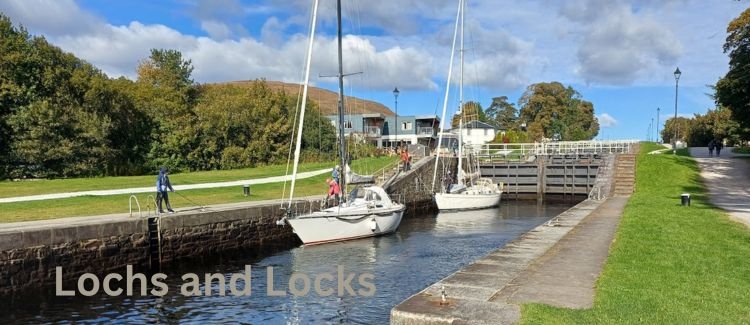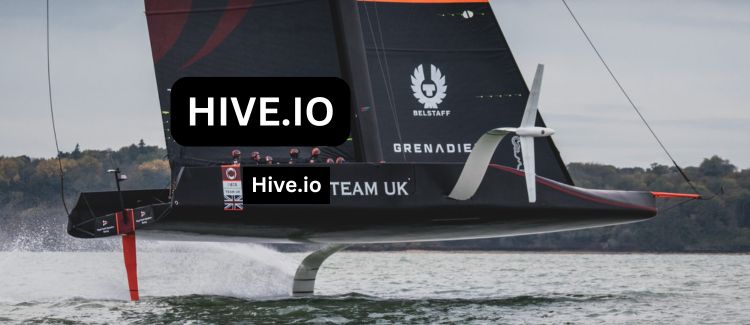
Just outside Fort William in Banavie is one end of the Caledonian Canal, designed by famous Scottish civil engineer, Thomas Telford which links the Atlantic Ocean, via Loch Linnhe to Inverness and the North Sea on Scotland's East coast, in reality, turning the North of Scotland into an island and was completed in 1822, 12 years late!
Yet again, the weather gods were smiling kindly upon us. It was warm. The azure skies were punctuated by a few billowing white clouds and as always, the majestic mountains provided a dramatic backdrop.
The canal is only partly man-made as it connects a number of deep water, natural lochs together including the infamous Loch Ness where the monster is said to live.
To compensate for the natural rise and fall of the land, the canal has a number of locks which are staircases for boats that allow a canal to traverse the ups and downs of the landscape. Where we are, here at Corpach, the end of the canal drops down by a final 20 metres to sea level, using a staircase of 8 consecutive locks named Neptune’s Staircase.. This is the longest run of locks in not just Scotland, but the whole of the UK.

Looking up the staircase of locks. It's kept really neat and tidy with the path being the start (or end!) of the Great Glen Way National Trail that can walked or cycled. On the right is a cafe. There's always a cafe. Sadly this one was closed!
I’ve been here a number of times before but never managed to see any boats using the locks but this time, I was lucky. Doubly so as they weren’t just boats, but sailing boats, and I love sailing boats!
Several YouTube sailing channels I follow have traversed the entire canal in the last few years, and I’ve followed with interest as ocean-going yachts cross the Scottish highlands on a body of water that becomes as narrow as 10 metres in width, so I was really happy to see this pair of yachts making the trip down the staircase at what must have been the end of their trip across the canal.

In the final lock chamber. Watch the water level...

Its quite a drop. Probably around 2.5m for each step of the staircase.
But never mind the width, what about the depth? Sailing boats have a weighted keel which drops deep into the water to provide them with stability, using the same effect as a pendulum. When the wind blows the boat heels and the keel stops it from blowing right over and capsizing. The problem is that usually, canals have a water depth of only around a metre and the draft (depth underwater) of these two boats could be as much as double that. Luckily, Thomas Telford designed the canal to be used by very large heavy steamships and the maximum dimension of watercraft that can safely navigate the canal is; Length 150 feet (45.72m), Beam (width) 35 feet (10.67m), Draft (depth below the water) 15 feet 6 inches (4.1m) and Air Draft (Height above the water) 115 feet (35m).
Our timing was extremely lucky as they only had the final three locks to go before the swing bridge that carries the railway over the canal opened and they sailed the final few hundred metres to the sea lock that sets them free into the tidal Loch Linnhe.
The lock gates are angled so the weight of the water behind them pushes against them to keep them closed. The sluices are opened to release the water from one lock chamber to the next. When the water has drained into the lower, next lock and becomes level, it's quite simple for one person to push each gate open. However, here at Neptune’s staircase, the gates are electric and hydraulically operated and you get help from the very friendly local team of lockkeepers who also found time to happily answer a few questions and chat about the operation of the locks. One of the things they did say was that boats needed to be booked in advance to traverse the locks so a quick phone call to them for the schedule and the guesswork of turning up to see the locks in use would be removed!

The lock gates are angled so they are forced tightly together when the level of the water in the chamber above it is higher than the one below.
There is something so aesthetically pleasing about a sailing boat, even when running under engine power. The sleek lines and graceful motion is soothing and graceful as they appear to move effortlessly through the water.


One last set of gates and they're free, all the way to the Atlantic....except for the swing bridge railway crossing and sea lock about 500 metres further on!
As for these boats, I couldn’t work out the smaller of the two but the larger one was easy to identify, it being my dream boat. It’s a Rival 41A. The ‘A’ model is the one with an aft (rear) cockpit, the ‘CC’ model has a centre cockpit and aft owner's cabin. She’s just over 12m long and displaces 10 tonnes and she's gorgeous!
There were only 57 of this model made between 1973 and 1982 and if you’re wondering how much you'd have to pay for one, a well-maintained, later model will set you back around £100,000. Bloody hell! That’s a lot of money for a 40+ year old sailing boat.
Despite her size, she can still be set up to sail single-handedly, as in the case of this particular craft which only had one person aboard. The front boat had a crew of three.

On 'Truant of Oamaru' (talk about pretentious names!), notice the lines (ropes) all running neatly across the cabin-top and back to the dodger (tent thing covering the companionway, or hatch to go below deck) where they are all hanked ready for use and also, the additional winches in the same location.

And they're gone. In this photo, you can just see the barriers for the rising road bridge in front of the final set of gates, and as always, a stunning backscene.
The boats take about 90 minutes in total to pass from top to bottom and this was a really pleasant way to spend an hour, especially in such glorious weather.
Thanks so much for dropping by and I hope everyone is having a wonderful weekend.
Martin
@nathen007
As always, sources and further resources for your own interest. This post has been pinned to the wonderful @worldmappin
www.rivalowners.co.uk
https://en.wikipedia.org/wiki/Caledonian_Canal





